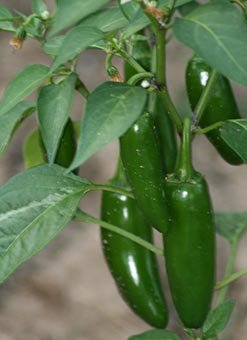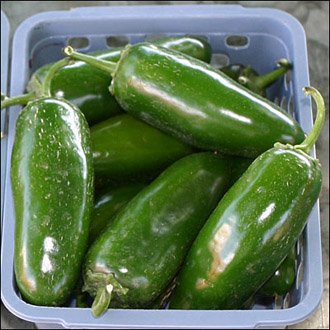Jalapeno Peppers Nutrition facts
Jalapeno peppers are among the favored varieties of chili peppers used in North American cuisine, particularly in the Southern states where Tex-Mex cuisine is popular. Like other chili peppers, jalapenos originated in Mexico. In fact, the name "jalapeno" is derived from Xalapa, a provincial capital in the Eastern Mexican Veracruz state, where early settlers cultivated the crop for centuries. Later, it was introduced to the rest of the world through Spanish explorers.
Botanically, jalapenos are fruit pods from the nightshade family (Solanaceae), specifically in the genus Capsicum. Scientific name: Capsicum annuum.
 |
| Jalapeno chili peppers. Photo courtesy: Ken Cook |
Jalapeno is a perennial small herbaceous plant with a woody stem that can grow up to a meter in height. It thrives in fertile, well-drained soil and requires adequate sunlight and moisture for optimal growth, influencing its foliage, flowering, and fruiting conditions.
After approximately 45 days post-transplantation, the Jalapeno plant produces tiny white flowers, followed by green pepper pods around 60 days later. When fully mature, these pods develop small cracks around their shoulders. The process of harvesting ripe red fruits, known as chipotle, can extend over several months.
The pods typically measure between 4 to 10 cm in length and feature smooth, shiny skin with a blunt, slightly tapering tip. Inside, each fruit contains numerous tiny, white, circular, and flat seeds, which adhere to the central, white placenta. Similar to other chili peppers, Jalapenos possess a strong spicy flavor derived from specific active alkaloid compounds such as capsaicin, capsanthin, and capsorubin.
On the Scoville scale, which measures the heat intensity of chili peppers, Jalapeños fall within the medium-hot range of 2,500 to 4,000 Scoville Heat Units (SHU). For comparison, sweet bell peppers have zero units, while Mexican habañeros range from 200,000 to 500,000 units.
Health Benefits of Jalapeno Peppers
- Chilies contain a health-benefiting alkaloid compound, capsaicin, which gives them a strong spicy, pungent character. The tolerance level of peppers in human beings, including jalapeno peppers, may have wide individual variations. However, they should be consumed in moderation to avoid any untoward experiences. Nonetheless, they are packed with an impressive list of phytochemical compounds that are known to have disease-preventing and health-promoting properties.
- Capsaicin has been found to have antibacterial, anticarcinogenic, analgesic, and antidiabetic properties, at least in some early laboratory studies on experimental mammals. It is also found to reduce LDL cholesterol levels in obese individuals.
- Fresh jalapeno peppers are a rich source of vitamin C. Ripe fruits have more of this vitamin than raw greens. 100 g provides about 118.6 µg or about 198% of RDA.
- Vitamin C is a potent water-soluble antioxidant. It is required for collagen synthesis within the body. Collagen is the main structural protein needed for maintaining the integrity of blood vessels, skin, tissues, organs, and bones.
- Regular consumption of foods rich in vitamin C helps the body protect from scurvy and boosts immunity to fight against infectious agents and scavenge harmful, pro-inflammatory free radicals from the body.
- Furthermore, they contain other valuable antioxidants such as vitamin A, and flavonoids like ß-carotene, α-carotene, lutein, zeaxanthin, and cryptoxanthin. These antioxidant substances in capsicum help to protect the body from injurious effects of free radicals generated by stress and disease conditions.
- Jalapeno chilies characteristically contain more pyridoxine, vitamin E, and vitamin K than other varieties of peppers. Vitamin K increases bone mass by promoting osteoblastic activity. It also has a beneficial effect in Alzheimer's disease patients by limiting neuronal damage in their brains.
| Principle | Nutrient Value | Percent of RDA |
|---|---|---|
| Energy | 29 Kcal | 1.5% |
| Carbohydrates | 6.50 g | 5% |
| Protein | 0.91 g | 2% |
| Total Fat | 0.37 g | 2% |
| Cholesterol | 0 mg | 0% |
| Dietary Fiber | 2.8 g | 7% |
| Vitamins | ||
| Folates | 27 µg | 7% |
| Niacin | 1.280 mg | 8% |
| Pantothenic acid | 0.315 mg | 6% |
| Pyridoxine | 0.419 mg | 32% |
| Riboflavin | 0.070 mg | 5% |
| Thiamin | 0.040 mg | 3% |
| Vitamin A | 1078 IU | 36% |
| Vitamin C | 118.6 mg | 198% |
| Vitamin E | 3.58 mg | 24% |
| Vitamin K | 18.5 µg | 15% |
| Electrolytes | ||
| Sodium | 3 mg | <0.5% |
| Potassium | 248 mg | 5% |
| Minerals | ||
| Calcium | 12 mg | 1.2 % |
| Copper | 0.046 mg | 5% |
| Iron | 0.25 mg | 3% |
| Magnesium | 15 mg | 4% |
| Manganese | 0.097 mg | 4% |
| Phosphorus | 26 mg | 5% |
| Selenium | 0.4 µg | <1% |
| Zinc | 0.14 mg | 1% |
| Phyto-nutrients | ||
| Carotene-ß | 561 µg | -- |
| Carotene-α | 67 µg | -- |
| Cryptoxanthin-ß | 105 µg | -- |
| Lutein-zeaxanthin | 861 µg | -- |
Selection and Storage
 |
| Fresh raw green jalapeno peppers in a market. Photo: La Grande Farmers' market. |
Fresh green and ripe jalapeno peppers are readily available in US markets throughout the year. During the winter months, they are imported from Central American countries, especially from Mexico. Organic pods may be found in local farmers' markets.
When purchasing, choose fresh, green, firm peppers that are uniform in size, featuring smooth, shiny skin and blunt ends. It is acceptable for jalapenos to have white markings on the shoulder ends. Avoid purchasing dry, wilted pods, as well as those with cracks, cuts, or surface bruising.
For storage at home, place the peppers in a vegetable compartment inside the refrigerator set at high relative humidity. They will keep well for up to a week. Pickled jalapenos can be stored for several months when kept in the fridge.
Preparation and Serving methods
To prepare jalapenos, begin by washing them in cold water and patting them dry with a soft absorbent towel. It is advisable to wear gloves when handling hot chili peppers. Remove the stems, then chop or slice them according to your preference. To reduce their heat, discard the seeds and central white placenta if desired. Grilling them under mild heat not only reduces their spiciness but also adds a smoky flavor.
Jalapenos have become popular in US households due to their versatility in various cuisines, such as Tex-Mex cuisine (Texas-Mexican cuisine). Raw green, grilled, smoked, or pickled jalapenos are used in a wide range of Latin American, Spanish, Caribbean, and Asian dishes.
Here are some serving tips:

|
| Pizza with jalapeno peppers, baby corn, and black olives topping. |
Jalapenos can be used as a substitute for bell peppers in the preparation of ratatouille, a traditional Occitanian recipe.
Raw green jalapeno peppers can be added along with tomatoes and white onion to make fresh Pico de gallo.
You can experiment with other fruits and vegetables to create salsa, guacamole, chutney, and salads.
Split jalapenos halfway lengthwise, remove the seeds, and stuff them with sausage, cheese, etc., to prepare stuffed jalapenos, also known as jalapeno poppers.
Mexican and Tex-Mex American cuisine prominently features smoke-dried jalapenos, known as chipotle.
Add jalapeno rings as toppings on pizzas.
Pickled jalapenos are commonly eaten with sandwiches, tortillas, burgers, and more.
Jalapeno peppers are a staple ingredient in mouthwatering Tex-Mex cuisine, including nachos, chili con queso, fajitas, and more.
They also contribute distinctive flavor and spiciness to vegetable stews, poultry, meat, and seafood dishes.
Safety Profile
Similar to other hot chili peppers, jalapenos also contain an active component called capsaicin, which imparts a strong spicy, pungent character. Even consuming a small amount may lead to severe irritation and a burning sensation in the mouth, tongue, and throat.
When capsaicin in jalapeno peppers comes into contact with the mucosa of the oral cavity, throat, and stomach, it initially triggers inflammation and may soon cause a severe burning sensation, perceived as 'hot,' through free nerve endings embedded in the mucosa. Consuming cold yogurt dilutes the concentration of capsaicin, prevents its contact with the stomach walls, and may help alleviate the burning pain.
Avoid touching your eyes with fingers contaminated with chili pepper. If accidental contact occurs, thoroughly rinse your eyes with cold water to reduce irritation.
Similar to other chilies, jalapeno peppers may exacerbate existing gastritis, stomach ulcers, and gastro-esophageal reflux (GER) conditions.
Extended consumption of old, spoiled chilies poses the risk of exposure to certain chemical compounds such as aflatoxin (fungal mold), which are known to cause stomach, liver, and colon cancers. (Medical disclaimer).
Also read ≻≻
≻≻ Poblano peppers nutrition facts.
≻≻ Bell pepper nutrition facts.
≻≻-Back to Spices from Jalapeno-peppers. Visit here for an impressive list of healthy spices with complete illustrations of their nutrition facts and health benefits.
≻≻-Back to Home page.
Further reading:
USDA National Nutrient Database. (opens in new window)
Agri Life Extension-Texas A&M System. (Opens in new window)